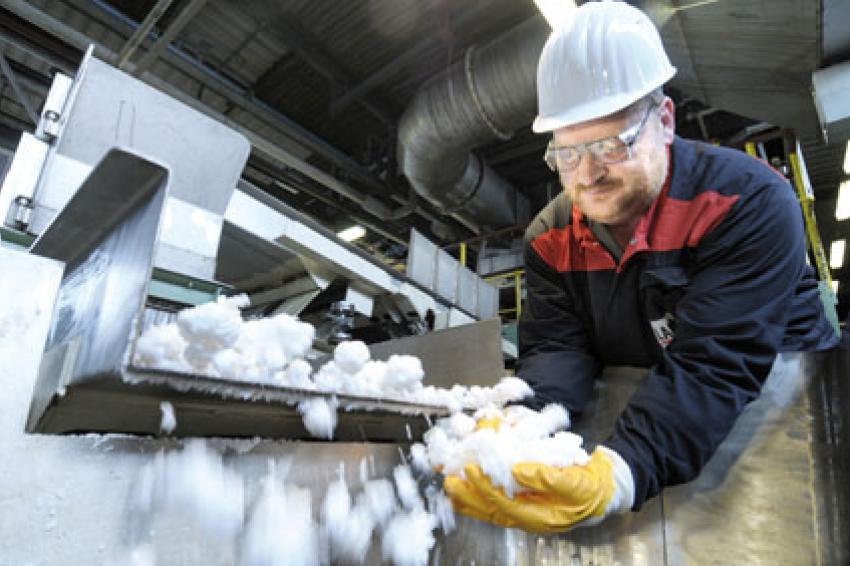Elastomers for Sustainable Technologies
Ductile Materials with an Unyielding Function
When people talk about sustainability, they seldom consider the tremendous opportunities that rubber offers in today‘s technological world. In fact, nowadays there are few machines and pieces of equipment where elastomers are not at the heart of things, assuming important functions such as saving energy, avoiding waste or helping to conserve resources.
Perhaps the best-known example of the potential of modern, high-performance elastomers for saving energy is that of tires, which account for 20 to 30 percent of the fuel consumption of a car. The introduction of so-called „green tires" in the 1980s demonstrated how special elastomers can save fuel: the combination of styrene-butadiene synthetic rubber with the filler silica and silanes lowered the rolling resistance by around 20 percent. Leverkusen-based synthetic rubber pioneer Lanxess is confident that this figure can be reduced by a further 10 percent within the foreseeable future (Fig. 1).
Efficiency Revolution through Synthetic Rubber
One of the reasons for the efficiency revolution of the 1980s was the improvement of the bond between the filler particles and the rubber. New elastomers enveloped the silica particles particularly effectively, as a result of which they were less able to rub against each other. Less friction means less heat build-up, and thus lower rolling resistance. An improved bond with the filler particles can be provided via anchor groups, through which the rubber can bond better to the silica surface. Lanxess has succeeded in drastically increasing the density of these anchor groups in its new elastomers. And that bodes well for the future!
Producers are also pinning their hopes on neodymium polybutadiene, or Nd-BR for short. The particularly favorable molecular weight distribution of modern Nd-BR grades ensures that the rubber contains fewer „loose ends" than many other types of rubber used for tire production. Like torn expander cords, these make little contribution to transferring forces and heat up the rubber unnecessarily.
A further advantage of Nd-BR, thanks to its particularly high content of so-called cis bonds in the polymer, is that its structure is particularly homogeneous. Consequently, these molecules bind together more easily under tensile load and can thus reinforce components particularly effectively. Normally, this also results in a longer service life. Tires with carcasses of rugged synthetic rubber can also be easily recycled, bringing about further savings of resources - retreads and remolds are the words that come to mind here. It is also quite possible that, through the higher abrasion resistance of modern synthetic rubber, particulate matter in our towns and cities can be reduced.
Environmental Sinners Exposed
The problem was that until now it has been almost impossible to tell whether or not a tire has been designed as an energy saver with the help of modern polymer chemistry. In Europe, that will soon change. With the introduction of tire labeling, tire buyers will, from the end of 2010, be able to distinguish at a glance the fuel-saving products from the environmental sinners. The possible extra cost of category A tires will soon pay for itself at the filling station.
This does not, by the way, apply only to drivers of gasoline and diesel vehicles. Energy-saving tires are especially interesting when it comes to electric cars: The less energy swallowed up by the tires, the greater the range of the electrically propelled vehicle. Just a few additional kilometers can be an important sales argument here.
Other alternative propulsion concepts also benefit from modern synthetic rubber (Fig. 2). Biodiesel is one example. The vegetable oil methyl esters contained in biodiesel represent a particular challenge for rubber articles, as not even high-performance elastomers such as hydrogenated nitrile-butadiene rubber (HNBR) are always able to cope with them. Yet rubber technologists often find it very difficult to do without these products because of their high dynamic load resistance, tensile strength and elongation at break. One possible solution is to use HNBR grades with a higher nitrile content and thus higher polarity. Lanxess recently introduced high-polar HNBR elastomers with acrylonitrile contents of up to 50.5 percent (specification maximum), which are noted above all for their highly reproducible media resistance properties that are typical of fluorinated rubber. In measurements of the permeation rates of many polar solvents, for example, specimens made of „ultra-high ACN Therban" come out better than the manufacturer‘s previous HNBR formulations. In fact, the permeation rates of media with a high ethanol content (buzzword: bioethanol) are more than halved. An important point here is that the new Therban grades are also available in fully hydrogenated and thus particularly aging-resistant form.
High-Performance Elastomers for Alternative Fuels
A second example is natural gas. Drivers who opt for this kind of fuel emit significantly less CO2 and carbon monoxide, barely any particulate matter and significantly fewer nitrogen oxides than diesel vehicles. The challenges here, however, are the fuel tank seals, which are frequently made of (fluorinated) rubber. These become harder at low temperatures - also when filling up, for physical reasons - and can forfeit some of their sealing effect. Here again, one possible solution is to use seals made of HNBR, which are resistant to non-polar substances such as natural gas and are flexible down to temperatures of -40 C.
Fuel cells can also benefit from special types of rubber. With the aid of the nano-elastomer Nanoprene from Lanxess, it should be possible to design fuel cells with significantly higher operating temperatures than the conventional models, which can withstand temperatures of only 100 to 120 C. The higher the operating temperature, the higher the efficacy of these mini power plants is.
Solar And Wind Energy: Greater Safety with High-Performance Rubber
Synthetic rubber can also play an important role in tapping alternative sources of energy. According to trials carried out by Lanxess, solar cells, for example, can be produced lighter and more economically if during production the cells are embedded between two films of the transparent, UV-resistant EVM elastomer Levamelt (Fig. 3).
A related ethylene-vinyl acetate rubber is also doing good service in the cables that transport the solar power to the inverter. Safety cables made from Levapren compounds are noted for their outstanding fire properties, a quality that is also needed in wind turbines. These systems require weatherproof seals and gaskets made of weather-resistant synthetic rubber that can measure up to four meters in diameter as well as fail-proof electrical wiring. They naturally also need rubber damping elements that keep harmful vibrations away from the foundations. The high-ozone environment in the vicinity of power-generating plants is another ideal area of application for aging-resistant HNBR elastomers.
Lifting Treasure From Below Our Feet
But alternative energy sources can be tapped not only above our heads but also under our feet. For example, any company wanting to tap the earth‘s heat is dependent on extremely abrasion-resistant, heavy-duty rubber products. Heat resistance is also essential. Even temperatures of around 150 C - not unusual at depths of between three and five thousand meters - can be a big problem for non-saturated standard grades of rubber. Therban HT can withstand long-term service temperatures 15°C higher than standard HNBR, is a particularly interesting candidate for such extreme requirements.
Similar HNBR elastomers are used in steerable drilling heads, which basically turn the functional principle of a Moineau or PCP pump (progressive cavity pump) around. Here, the drill is set in motion as soon as liquid is pressed through the space between a rubber stator and a steel rotor. The rubber naturally needs to have outstanding abrasion values, because the drilling fluid can contain fine, abrasive particles of rock. Drills such as this are also used to tap oil reserves that were previously deemed inaccessible where the precious content often has to be made flowable by introducing hot steam. This, too, would quickly bring normal synthetic rubber to its knees. Other tools for working underground that are dependent on highly abrasion-resistant rubber materials are extender screw pumps or hoses in which the exceptionally abrasive drilling cuttings are transported above ground. Ideal solutiona are carboxylated HNBR grades such as Therban XT.
Cleaner Drinking Water Thanks to Elastomers
Another commodity that could, in the medium term, become just as short as energy, is drinking water. Synthetic rubber also plays an important role in the sensible use of this resource. Even the simplest of seals and gaskets can entail a considerable amount of know-how: simple grades of rubber often contain plasticizers that, over time, can be washed out by water and even serve as food for some microorganisms. Special-purpose elastomers such as special EPDM grades can, however, be processed into highly elastic rubber even without these additives. Another advantage is that they do not become too soft at elevated temperatures, ensuring a strong long-lasting seal.
Seawater can also dissolve important constituents out of standard rubber over the course of time. Normal types of rubber only have moderate resistance to ozone and UV light. This can make specialized rubber grades essential, for example in the construction of seawater desalination plants. On land, elastomers make the recovery of drinking water easier in pumps where the seals need to be particularly rugged because of the sludge accompanying the water.
The topic of drinking water also shows that sustainability is not just restricted to the mega-trend „energy supply". Sustainable technologies should, after all, secure the means of livelihood for future generations - and that also includes the challenges of world nutrition and health. Here, too, synthetic rubber often plays a fundamental role behind the scenes.
Take the harvesting of rice, for example - which, as we know, is an essential foodstuff for large sectors of the world population. To peel the rice grain, rubber-coated rollers are used. The surface characteristics and abrasion resistance of the rollers are decisive for economical application. Nitrile rubbers are frequently used for such applications. They more or less come stamped with approval for food-contact applications, as nitrile rubber is also commonly used in suction cups for breast milk and in seals for asthma sprays. Perhaps less spectacular from a technical point of view, but just as important for mankind, they are also used as membranes for fuel cells.









